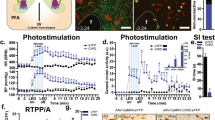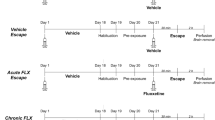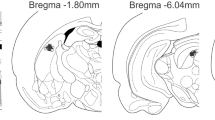Abstract
Rationale
Previous studies suggested that the dorsal column of the periaqueductal grey matter (dPAG) can be a target of neural pathways from hypothalamic nuclei involved in triggering fear-related defensive responses. In turn, evidence is provided suggesting that microinjection of the nitric oxide (NO) donor SIN-1 into the anterior hypothalamus (AH) of mice evokes panic-like behaviours and fear-induced antinociception. However, it is unknown whether the dPAG of mice mediates these latter defensive responses organised by AH neurons.
Objectives
This study was designed to examine the role of dPAG in mediating SIN-1-evoked fear-induced defensive behavioural and antinociceptive responses organised in the AH of mice.
Methods
First, neural tract tracing was performed to characterise the AH-dPAG pathways. Then, using neuropharmacological approaches, we evaluated the effects of dPAG pretreatment with either the non-selective synaptic blocker cobalt chloride (CoCl2; 1 mM/0.1 μL) or the competitive N-methyl-d-aspartate (NMDA) receptor antagonist LY235959 (0.1 nmol/0.1 μL) on defensive behaviours and antinociception induced by microinjections of SIN-1 in the AH of male C57BL/6 mice.
Results
AlexaFluor488-conjugated dextran-labelled axonal fibres from AH neurons were identified in both dorsomedial and dorsolateral PAG columns. Furthermore, we showed that pre-treatment of the dPAG with either CoCl2 or LY235959 inhibited freezing and impaired oriented escape and antinociception induced by infusions of SIN-1 into the AH.
Conclusions
These findings suggest that the panic-like freezing and oriented escape defensive behaviours, and fear-induced antinociception elicited by intra-AH microinjections of SIN-1 depend on the activation of dPAG NMDA receptors.








Similar content being viewed by others
Data availability
The data that support the findings of this study are available on request from the corresponding authors N.C. Coimbra and L.L. Falconi-Sobrinho.
References
Aimone LD, Bauer CA, Gebhart GF (1988) Brain-stem relays mediating stimulation-produced antinociception from the lateral hypothalamus in the rat. J Neurosci 8:2652–2663
Almada RC, Coimbra NC (2015) Recruitment of striatonigral disinhibitory and nigrotectal inhibitory GABAergic pathways during the organization of defensive behavior by mice in a dangerous environment with the venomous snake Bothrops alternatus (Reptilia, Viperidae). Synapse 69:299–313
Almada RC, Roncon CM, Elias-Filho DH, Coimbra NC (2015) Endocannabinoid signaling mechanisms in the substantia nigra pars reticulata modulate GABAergic nigrotectal pathways in mice threatened by urutu-cruzeiro venomous pit viper. Neuroscience 303:503–514
Almada RC, dos Anjos-Garcia T, da Silva JA, Pigatto GR, Wotjak CT, Coimbra NC (2021) The modulation of striatonigral and nigrotectal pathways by CB1 signalling in the substantia nigra pars reticulata regulates panic elicited in mice by urutu-cruzeiro lancehead pit vipers. Behav Brain Res 401:112996
Almada RC, Falconi-Sobrinho LL, da Silva JA, Wotjak CT, Coimbra NC (2022) Augmented anandamide signalling in the substantia nigra pars reticulata mediates panicolytic-like effects in mice confronted by Crotalus durissus terrificus pit vipers. Psychopharmacology 239:2753–2769
Anseloni VC, Coimbra NC, Morato S, Brandão ML (1999) A comparative study of the effects of morphine in the dorsal periaqueductal gray and nucleus accumbens of rats submitted to the elevated plus-maze test. Exp Brain Res 129:260–268
Bandler R, Shipley MT (1994) Columnar organization in midbrain periaqueductal gray: modules for emotional expression? Trends Neurosci 17:379–389
Baptista-de-Souza D, Pelarin V, Canto-de-Souza L, Nunes-de-Souza RL, Canto-de-Souza A (2018) Interplay between 5-HT2C and 5-HT1A receptors in the dorsal periaqueductal gray in the modulation of fear-induced antinociception in mice. Neuropharmacology 140:100–106
Basbaum AI, Fields HL (1978) Endogenous pain control mechanisms: review and hypothesis. Ann Neurol 4:451–462
Behbehani MM, Park MR, Clement ME (1988) Interactions between the lateral hypothalamus and the periaqueductal gray. J Neurosci 8:2780–2787
Biagioni AF, de Oliveira RC, de Oliveira R, da Silva JA, dos Anjos-Garcia T, Roncon CM, Corrado AP, Zangrossi H Jr, Coimbra NC (2016) 5-Hydroxytryptamine 1A receptors in the dorsomedial hypothalamus connected to dorsal raphe nucleus inputs modulate defensive behaviours and mediate innate fear-induced antinociception. Eur Neuropsychopharmacol 26:532–545
Blanchard RJ, Blanchard DC (1989) Attack and defense in rodents as ethoexperimental models for the study of emotion. Prog Neuropsychopharmacol Biol Psychiatry 13(Suppl):S3-14
Bolles RC, Fanselow MS (1980) A perceptual-defensive-recuperative model of fear and pain. Behav Brain Sci 3:291–301
Butler RK, Finn DP (2009) Stress-Induced Analgesia. Prog Neurobiol 88:184–202
Canteras NS (2002) The medial hypothalamic defensive system: hodological organization and functional implications. Pharmacol Biochem Behav 71:481–491
Canteras NS, Swanson LW (1992) The dorsal premammillary nucleus: an unusual component of the mammillary body. Proc Natl Acad Sci U S A 89:10089–10093
Canteras NS, Simerly RB, Swanson LW (1994) Organization of projections from the ventromedial nucleus of the hypothalamus: a Phaseolus vulgaris-leucoagglutinin study in the rat. J Comp Neurol 348:41–79
Carrive P (1993) The periaqueductal gray and defensive behavior: functional representation and neuronal organization. Behav Brain Res 58:27–47
Coimbra NC, Osaki MY, Eichenberger GCD, Ciscato JG Jr, Jucá CEB, Biojone CR (2000) Effects of opioid receptor blockade on defensive behavior elicited by electrical stimulation of the aversive substrates of the inferior colliculus in Rattus norvegicus (Rodentia Muridae). Psychopharmacol (Berl) 152(4):422–430
Coimbra NC, de Oliveira R, Freitas RL, Ribeiro SJ, Borelli KG, Pacagnella RC, Moreira JE, da Silva LA, Melo LL, Lunardi LO, Brandão ML (2006) Neuroanatomical approaches of the tectum-reticular pathways and immunohistochemical evidence for serotonin-positive perikarya on neuronal substrates of the superior colliculus and periaqueductal gray matter involved in the elaboration of the defensive behavior and fear-induced analgesia. Exp Neurol 197:93–112
Coimbra NC, Calvo F, Almada RC, Freitas RL, Paschoalin-Maurin T, dos Anjos-Garcia T, Elias-Filho DH, Ubiali WA, Lobão-Soares B, Tracey I (2017) Opioid neurotransmission modulates defensive behavior and fear-induced antinociception in dangerous environments. Neuroscience 354:178–195
Cornélio AM, Mendes-Gomes J, Fugimoto JS, Morgan MM, Nunes-de-Souza RL (2011) Environmentally induced antinociception and hyperalgesia in rats and mice. Brain Res 1415:56–62
da Silva Soares R Jr., Falconi-Sobrinho LL, dos Anjos-Garcia T, Coimbra NC (2019) 5-Hydroxytryptamine 2A receptors of the dorsal raphe nucleus modulate panic-like behaviours and mediate fear-induced antinociception elicited by neuronal activation in the central nucleus of the inferior colliculus. Behav Brain Res 358:71–81
de Paula Rodrigues BM, Coimbra NC (2022) CB1 receptor signalling mediates cannabidiol-induced panicolytic-like effects and defensive antinociception impairment in mice threatened by Bothrops jararaca lancehead pit vipers. J Psychopharmacol 36(12):1384–1396
de Freitas RL, Salgado-Rohner CJ, Hallak JEC, de Souza Crippa JA, Coimbra NC (2013) Involvement of prelimbic medial prefrontal cortex in panic-like elaborated defensive behaviour and innate fear-induced antinociception elicited by GABAA receptor blockade in the dorsomedial and ventromedial hypothalamic nuclei: role of the endocannabinoid CB1 receptor. Int J Neuropsychopharmacol 16(8):1781–1798
de Paula BB, Vieira-Rasteli EB, Calvo F, Coimbra NC, Leite-Panissi CRA (2022) Functional activation of the periaqueductal gray matter during conditioned and unconditioned fear in guinea pigs confronted with the Boa constrictor constrictor snake. Braz J Med Biol Res 55:e11542. https://doi.org/10.1590/1414-431X2021e11542
dos Anjos-Garcia T, Coimbra NC (2019) Opposing roles of dorsomedial hypothalamic CB1 and TRPV1 receptors in anandamide signaling during the panic-like response elicited in mice by Brazilian rainbow Boidae snakes. Psychopharmacology 236:1863–1874
dos Anjos-Garcia T, Ullah F, Falconi-Sobrinho LL (2017) Coimbra NC (2017) CB1 cannabinoid receptor-mediated anandamide signalling reduces the defensive behaviour evoked through GABAA receptor blockade in the dorsomedial division of the ventromedial hypothalamus. Neuropharmacology 113:156–166
Falconi-Sobrinho LL, Coimbra NC (2018) The nitric oxide donor SIN-1-produced panic-like behaviour and fear-induced antinociception are modulated by NMDA receptors in the anterior hypothalamus. J Psychopharmacol 32:711–722
Falconi-Sobrinho LL, dos Anjos-Garcia T, Elias-Filho DH, Coimbra NC (2017) Unravelling cortico-hypothalamic pathways regulating unconditioned fear-induced antinociception and defensive behaviours. Neuropharmacology 113(Part A):367–385
Falconi-Sobrinho LL, dos Anjos-Garcia T, de Oliveira R, Coimbra NC (2017) Decrease in NMDA receptor-signalling activity in the anterior cingulate cortex diminishes defensive behaviour and unconditioned fear-induced antinociception elicited by GABAergic tonic inhibition impairment in the posterior hypothalamus. Eur Neuropsychopharmacol 27:1120–1131
Falconi-Sobrinho LL, dos Anjos-Garcia T, Coimbra NC (2021) Nitric oxide-mediated defensive and antinociceptive responses organised at the anterior hypothalamus of mice are modulated by glutamatergic inputs from area 24b of the cingulate cortex. J Psychopharmacol 35:78–90
Ferreira-Sgobbi R, de Figueiredo RM, Frias AT, Matthiesen M, Batistela MF, Falconi-Sobrinho LL, Vilela-Costa HH, Sá SI, Lovick TA, Zangrossi H Jr, Coimbra NC (2017) Panic-like responses of female Wistar rats confronted by Bothrops alternatus pit vipers, or exposure to acute hypoxia: effect of oestrous cycle. Eur J Neurosci 55(1):32–48
Fields HL, Basbaum AI (1978) Brainstem control of spinal pain-transmission neurons. Annu Rev Physiol 40:217–248
Freitas RL, Uribe-Mariño A, Castiblanco-Urbina MA, Elias-Filho DH, Coimbra NC (2009) GABAA receptor blockade in dorsomedial and ventromedial nuclei of the hypothalamus evokes panic-like elaborated defensive behaviour followed by innate fear-induced antinociception. Brain Res 1305:118–131
Garthwaite J, Charles SL, Chess-Williams R (1988) Endothelium derived relaxing factor release on activation of NMDA receptors suggests role as intercellular messenger in the brain. Nature 336:385–388
Garthwaite J, Garthwaite G, Palmer RM, Moncada S (1989) NMDA receptor activation induces nitric oxide synthesis from arginine in rat brain slices. Eur J Pharmacol 172:413–416
Gross CT, Canteras NS (2012) The many paths to fear. Nat Rev Neurosci 13:651–658
Harris JA, Westbrook RF (1995) Effects of benzodiazepine microinjection into the amygdala or periaqueductal gray on the expression of conditioned fear and hypoalgesia in rats. Behav Neurosci 109:295–304
Helmstetter FJ (1992) The amygdala is essential for the expression of conditional hypoalgesia. Behav Neurosci 106:518–528
Khan AU, Falconi-Sobrinho LL, Dos Anjos-Garcia T, dos Santos Sampaio M de F, de Souza Crippa JA, Menescal-de-Oliveira L, Coimbra NC (2020) Cannabidiol-induced panicolytic-like effects and fear-induced antinociception impairment: the role of the CB1 receptor in the ventromedial hypothalamus. Psychopharmacology (Berl) 237:1063-1079
Lobão-Soares B, Walz R, Prediger RD, Freitas RL, Calvo F, Bianchin MM, Leite JP, Landemberger MC, Coimbra NC (2008) Cellular prion protein modulates defensive attention and innate fear-induced behaviour evoked in transgenic mice submitted to an agonistic encounter with the tropical coral snake Oxyrhopus guibei. Behav Brain Res 194:129–137
Miguel TT, Nunes-de-Souza RL (2006) Defensive-like behaviors and antinociception induced by NMDA injection into the periaqueductal gray of mice depend on nitric oxide synthesis. Brain Res 1076:42–48
Miguel TT, Gomes KS, Nunes-de-Souza RL (2012) Contrasting effects of nitric oxide and corticotropin-releasing factor within the dorsal periaqueductal gray on defensive behavior and nociception in mice. Braz J Med Biol Res 45:299–307
Milani H, Graeff FG (1987) GABA-benzodiazepine modulation of aversion in the medial hypothalamus of the rat. Pharmacol Biochem Behav 28:21–27
Millan MJ (2002) Descending control of pain. Prog Neurobiol 66:355–474
Paschoalin-Maurin T, dos Anjos-Garcia T, Falconi-Sobrinho LL, de Freitas RL, Coimbra JPC, Laure CJ, Coimbra NC (2008) The rodent-versus-wild snake paradigm as a model for studying anxiety- and panic-like behaviors: face, construct and predictive validities. Neuroscience 15:336–349
Paxinos G, Franklin KBJ (2001) The mouse brain in stereotaxic coordinates. Elsevier Academic Press, San Diego, CA
Prado WA, Roberts MH (1985) An assessment of the antinociceptive and aversive effects of stimulating identified sites in the rat brain. Brain Res 340:219–228
Remes O, Brayne C, van der Linde R, Lafortune L (2016) A systematic review of reviews on the prevalence of anxiety disorders in adult populations. Brain Behav 6(7):e00497
Samineni VK, Grajales-Reyes JG, Copits BA, O’Brien DE, Trigg SL, Gomez AM, Bruchas MR, Gereau RW 4th (2017) Divergent modulation of nociception by glutamatergic and GABAergic neuronal subpopulations in the periaqueductal gray. eNeuro 4(2): eNEURO.0129-16.2017
Shekhar A, DiMicco JA (1987) Defense reaction elicited by injection of GABA antagonists and synthesis inhibitors into the posterior hypothalamus in rats. Neuropharmacology 26:407–417
Steel Z, Marnane C, Iranpour C, Chey T, Jackson JW, Patel V, Silove D (2014) The global prevalence of common mental disorders: a systematic review and meta-analysis 1980–2013. Int J Epidemiol 43:476–493
Tovote P, Esposito MS, Botta P, Chaudun F, Fadok JP, Markovic M, Wolff SB, Ramakrishnan C, Fenno L, Deisseroth K, Herry C, Arber S, Lüthi A (2006) Midbrain circuits for defensive behaviour. Nature 534:206–212
Ullah F, dos Anjos-Garcia T, dos Santos IR, Biagioni AF, Coimbra NC (2015) Relevance of dorsomedial hypothalamus, dorsomedial division of the ventromedial hypothalamus and the dorsal periaqueductal gray matter in the organization of freezing or oriented and non-oriented escape emotional behaviors. Behav Brain Res 293:143–152
Ullah F, dos Anjos-Garcia T, Mendes-Gomes J, Elias-Filho DH, Falconi-Sobrinho LL, de Freitas RL, Khan AU, de Oliveira R, Coimbra NC (2017) Connexions between the dorsomedial division of the ventromedial hypothalamus and the dorsal periaqueductal grey matter are critical in the elaboration of hypothalamically mediated panic-like behaviour. Behav Brain Res 319:135–147
Uribe-Mariño A, Francisco A, Castiblanco-Urbina MA, Twardowschy A, Salgado-Rohner CJ, Crippa JAS, Hallak JEC, Zuardi AW, Coimbra NC (2012) Antiaversive effects of cannabidiol on innate fear-induced behaviors evoked by an ethological model of panic attacks based on a prey vs the wild snake Epicrates cenchria crassus confrontation paradigm. Neuropsychopharmacology 37:412–421
Wang L, Chen IZ, Lin D (2015) Collateral pathways from the ventromedial hypothalamus mediate defensive behaviors. Neuron 18:1344–1358
Wang W, Schuette PJ, La-Vu MQ, Torossian A, Tobias BC, Ceko M, Kragel PA, Reis FM, Ji S, Sehgal M, Maesta-Pereira S, Chakerian M, Silva AJ, Canteras NS, Wager T, Kao JC, Adhikari A (2021) Dorsal premammillary projection to periaqueductal gray controls escape vigor from innate and conditioned threats. eLife 10:e69178
Watson TC, Cerminara NL, Lumb BM, Apps R (2016) Neural correlates of fear in the periaqueductal gray. J Neurosci 36:12707–12719
Funding
The authors disclosed receipt of the following financial support for the research, authorship and/or publication of this article: This work was supported by Fundação de Amparo à Pesquisa do Estado de São Paulo (FAPESP) (grant numbers 2007/01174–1, 2012/03798–0, 2017/11855–8, and 2020/15050–7) and Conselho Nacional de Pesquisa e Desenvolvimento Tecnológico (CNPq) (grant numbers 483763/2010–1, 474853/2013–6 and 427397/2018–9). L.L. Falconi-Sobrinho was supported by FAPESP (Scientiae Magister grant 2013/10984–8; post-doctoral grant 2019/05255–3) and CNPq (Sc.M. fellowship grant 134267/2013–3; Scientiae Doctor fellowship grant 145258/2015–7). T. dos Anjos-Garcia was financially supported by CNPq (Sc.M. fellowship grant 130124/2012–5; Sc.D. fellowship grant 141124/2014–8) and FAPESP (postdoctoral grant 2017/22647–7). P. M. Hernandes was supported by CNPq (Sc.D. fellowship grant 142030/2020–1). B.M. de Paula Rodrigues was financially supported by CAPES (M.Sc. and Sc.D. fellowships, CAPES–PROEX-Psicobiologia-FFCLRP-USP grant 0487 and CAPES-PROEX grant 8887.475628/2020–00, respectively). R.C. Almada was supported by FAPESP (postdoctoral fellowship process 2012/22681–7, Young Investigator Program: research grant process 2018/03898–1 and researcher fellowship process 2019/01713–7) and CAPES (postdoctoral fellowship process PNPD20131680-33002029012P3). N. C. Coimbra is a researcher supported by CNPq (PQ1A grants 301905/2010–0 and 301341/2015–0; PQ2 grant 302605/2021–5).
Author information
Authors and Affiliations
Contributions
L.L.F.-S. designed and executed the experiments, analysed and interpreted the data, designed the figures and wrote the manuscript. T. dos A.-G. collaborated on pharmacological approaches. P.M.H and R.C.A collaborated in neuroanatomical approaches. B.M.de P.R. performed the place preference behaviour-related experiments. N.C.C designed the experiments, invented the enriched polygonal arena test, performed the place preference experiments, recorded the neural tract tracing images, analysed and interpreted the data, and wrote the manuscript. All authors approved the final version of the manuscript and are entirely responsible for the scientific content of this article.
Corresponding authors
Ethics declarations
Conflict of interests
The authors declare no competing interests.
Additional information
Publisher's note
Springer Nature remains neutral with regard to jurisdictional claims in published maps and institutional affiliations.
Rights and permissions
Springer Nature or its licensor (e.g. a society or other partner) holds exclusive rights to this article under a publishing agreement with the author(s) or other rightsholder(s); author self-archiving of the accepted manuscript version of this article is solely governed by the terms of such publishing agreement and applicable law.
About this article
Cite this article
Falconi-Sobrinho, L.L., dos Anjos-Garcia, T., Hernandes, P.M. et al. Unravelling the dorsal periaqueductal grey matter NMDA receptors relevance in the nitric oxide-mediated panic‑like behaviour and defensive antinociception organised by the anterior hypothalamus of male mice. Psychopharmacology 240, 319–335 (2023). https://doi.org/10.1007/s00213-023-06309-7
Received:
Accepted:
Published:
Issue Date:
DOI: https://doi.org/10.1007/s00213-023-06309-7




